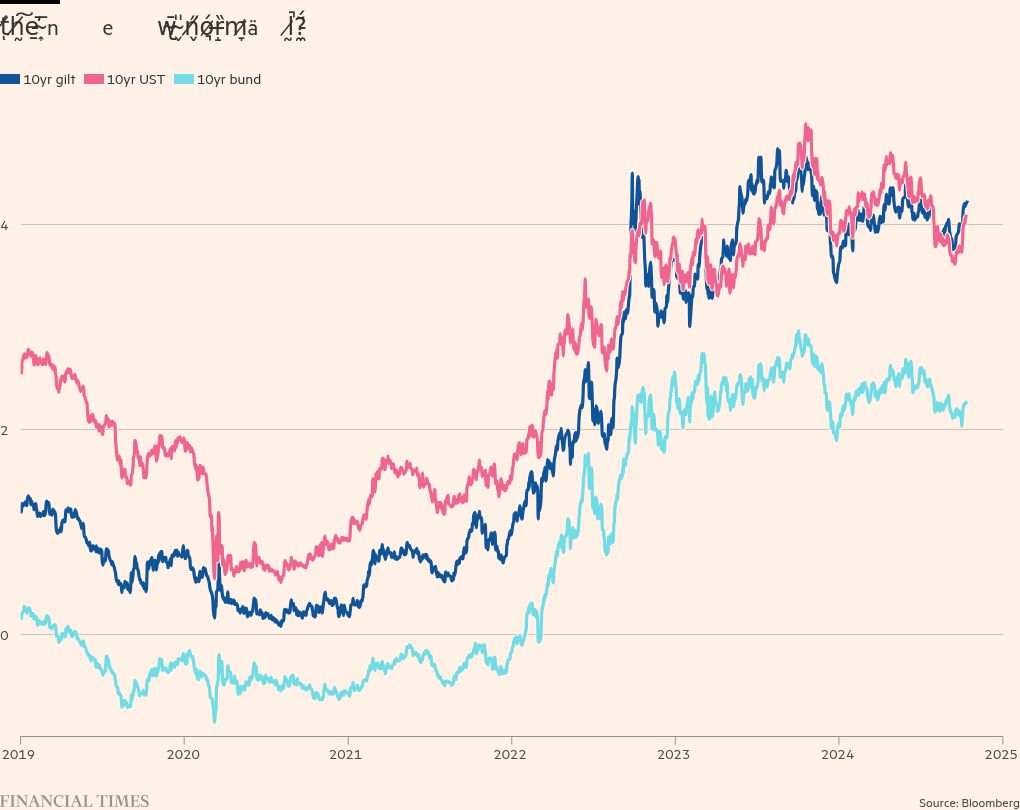
Unlock the Editor’s Digest for free
Roula Khalaf, Editor of the FT, selects her favourite stories in this weekly newsletter.
The UK Budget, Rachel Reeves’ first as Chancellor, will take place on 30 October. Reeves is expected to raise taxes in some form, and also to change the definition of public debt used for the UK’s fiscal rules to allow for more borrowing.
One simple observation is that if you’re going to do a tax-raising Budget, having it take place the day before Hallowe’en isn’t a great idea from an optics perspective.
MainFT has lent into spooky season, serving the Chancellor such delights as:
The UK’s long-term borrowing costs have climbed sharply, fuelled by investor concerns about the Labour government’s Budget, pushing the gap with Germany to the widest in more than a year.
With three weeks to go to Rachel Reeves’ first Budget, bondholders say the UK chancellor will have to walk a “tightrope” if she is to proceed with her borrowing and investment plans without triggering a gilt sell-off.
There’s some decent evidence that gilts aren’t what they used to be, and have properly abandoned the comfortable spot where they used to sit between bunds and treasuries, to offer US-style yields:

Counterfactuals — such as where yields would be without the massive repricing that occurred in late 2022 — are worth considering, but also are not.
The recent shift, is, perhaps, more remarkable. Is it because of budgetary concerns? And, moreover, is it worth worrying about?
No, says Pantheon Macroeconomics’s Elliott Jordan-Doak:
We rather think surging interest rates in the past two weeks have been driven primarily by stronger-than-expected US data and oil prices rising as a result of the intensifying conflict in the Middle East. The prospect of more gilt issuance than expected has likely added to the rise in gilts yields, but only modestly. The previous government was already gaming the fiscal rules and leaving government debt on an unsustainable trajectory (see here), which failed to cause a market reaction. We doubt tweaking the fiscal rules to allow more—potentially productive—investment would cause markets to reappraise sovereign risk premia much
No, says Panmure Gordon’s Simon French:
A clear aversion to UK assets triggered a 6% drawdown in Sterling in 2022. Since the 2024 General Election the Sterling Index is up by almost 1%. This is one of the major countervailing datapoints to the idea that appetite for UK sovereign assets is facing a similar waning moment…
Gilt yields of course do not move in an international vacuum. Nor are they solely a function of domestic fiscal policy – either perceived or realised. There have been plenty of geopolitical crosswinds to contextualise this move in Gilt yields, including UK economic data that has remained remarkably robust in recent months.
No, says Peel Hunt’s Kallum Pickering:
The uptick in UK 10-year gilt yields of c.50bp since mid-September seems to have sparked concern among some commentators that bond markets may be growing apprehensive about overborrowing by Chancellor Rachel Reeves in the upcoming 30 October Budget. It follows her hints that she may increase debt to finance a needed step-up in public investment. Upon closer examination, however, such concerns look exaggerated. For now, the rise in yields can more plausibly be attributed to a host of other mostly global factors.
Over the same period, Brent crude oil prices have risen by around 8% while natural gas prices are up by some 10%. Reacting to the prospect of a modest energy-related inflation uptick, 10-year bond yields have risen across all G7 economies: in the US by c.50bp, in Canada by c.40bp, in France by c.20bp, in Germany by c.15bp, in Japan by c.15bp, and in Italy by c.10bp.
The rise in UK yields is in line with the US uptick but notably higher than in other major Eurozone economies. Is the spread widening versus Europe a concern? Not really, since it has occurred alongside directionally-consistent shifts in consensus expectations. Over the past month, Bloomberg consensus growth forecasts for the UK have been revised up from 1.3% YoY to 1.4% for 2024 while projections for the US have increased from 2.5% to 2.6% for 2024 and from 1.7% to 1.8% for 2025. Consensus expectations for the Eurozone in 2026, meanwhile, have been cut from 1.5% to 1.4% – with 0.1pp downgrades for both 2024 and 2025 for Germany.
No, says TS Lombard’s Dario Perkins:
Is there a moron risk premium in UK bonds? Trussonomics inspired a specific market reaction – yields surged & the currency simultaneously plunged. The (seminal) MRP captured this (EM-style) correlation between the two asset classes, which turned decisively positive in the autumn of ‘22. But that behaviour didn’t last, and although the relationship between sterling and gilts hasn’t gone back to the persistent negative correlation of the 2010s, we are not seeing those nastier moron dynamic today…
The explanation for relatively higher yields in the UK is simpler – it is about PERCEIVED inflation stickiness, and a BoE that is forced to cut interest rates slower than most of its peers. These charts show that it is not just 10-year yields that are stubbornly high, it is also 2-year yields. And 2-year yields are a better reflection of monetary policy, not “fiscal risk”. Whatever MRP existed during Trussonomics, was gone by mid-2023.
Ish, says Capital Economics’s Joe Maher:
We think there is limited evidence of fiscal doubts creeping into the market. For one, much of the recent fall in the pound against the dollar from $1.34 to $1.30 can be explained by changes in relative short-term interest rate expectations. (See Chart 2.) If the markets were truly concerned about the government’s fiscal credibility, we would likely see both a rise in UK relative rate expectations and a fall in the pound, which occurred during the infamous Trussonomics debacle. Instead, the larger rise in yields in the UK than elsewhere can be explained by investors expecting the Budget to result in stronger near-term demand and higher interest rates.
Meh, says Goldman Sachs:
Our estimates in the UK show an increase in term premium driving the move higher in Gilt yields, leading to cross-market underperformance that we think will fade on the far-side of the budget. We still expect the 10y to underperform on the Gilt curve.
So, with much of the sellside sounding bullish, that’s all settled. We’ll see you on Hallowe’en for the meltdown.